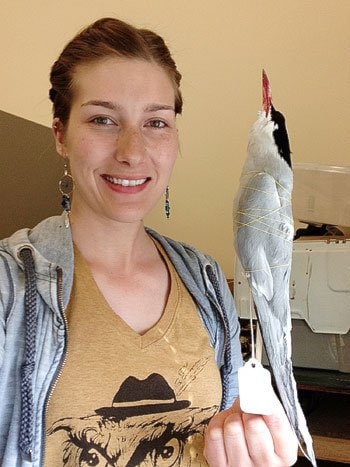Five years ago, Shyloh van Delft attended a young-ornithologists’ workshop at Long Point Bird Observatory on Lake Erie in Ontario. She was less than thrilled to be presented with a dead bird to skin out and prepare as a study specimen. “I’ve never really been a blood and innards sort of person,” van Delft says.
At any rate, that first desiccated avian was 70 bird skins ago and today van Delft is much more comfortable with the rigours, the occasional stench and the mess of bird skinning. She knows that a properly prepared skin can serve as an essential learning tool. And she is quickly becoming a valuable resource among the many other hard-working Yukon College biology students who are preparing to take over from senior territorial scientists, such as her much-admired mentor biologist Dave Mossop.
A born-and-raised Yukoner, van Delft has come a long way since the Girl Guides’ bird walk she participated in at age 11. Somehow she missed the red-wing blackbird everyone else saw, but rather than be discouraged she became determined. “I always try to become a better birder,” she says, more than a decade later. She is convinced that preparing bird skins is a big step in that direction ... for herself and for her colleagues.
The bird-skinning task begins with the gift of a dead bird. Most birds in the Yukon College collection have been donated by “just folks” who found the little bodies following collisions with windows or encounters with house cats. These are the two most common causes of bird mortality, says van Delft.
Anyone can donate a dead bird found below a picture window, or in the cat’s toy box, to science. The collection procedure is simple. Wear gloves. Place the bird in a sealed bag, and freeze immediately until you can get the bird to a drop-off point: Yukon Research Centre, Environment Yukon or Canadian Wildlife Service, which all hold permits to allow them to possess dead wild birds.
“I was warned when I started skinning these specimens that it is possible to catch contagions from birds,” says van Delft. “You have to practise various safety measures, including working with gloves, washing hands very well and keeping the workplace clean. After preparing a bird, don’t start eating your lunch without washing your hands. At least I wouldn’t,” she stresses.
Before a bird is skinned, measurements must be made. That’s a task Dave Mossop usually undertakes, says van Delft. He measures the length of the foot, the length of the bill, the wingspan and other features, and determines the age, sex and species of the bird. Information about each study skin is recorded in a data base.
“Essential for skinning are a scalpel, of course, and some borax,” van Delft says. The borax is sprinkled on the bird during the skinning process in order to soak up any fluids. It is all a very delicate process, she stresses. “The skins are so incredibly thin. They are completely transparent, thinner than paper.
“So you basically take off the skin, leave the leg bones and wing bones on, but clean them. You also keep the skull, so you leave skin attached around the beak. You clean out the skull and stuff it full of cotton.”
Then the skin goes back over the skull. At that point,
you get your little skewer and wrap cotton around it to make a body. You insert the skewer into the bird all the way up into the skull. The head is tipped upward to make for easier side-by-side storage in drawers.
Little birds take about a week to properly dry. Larger ones, like swans, take several weeks, Van Delft says, adding that she hasn’t yet prepared a swan.
“There is a view out there that study skins are bad, that they are unethical,” says the biology student. “But I don’t believe this.” Turning the already deceased bird into an educational tool serves science, helps make people more aware of birds, and yes, could help alert wildlife managers and health workers to any contagions that might be entering an ecosystem, she adds. As well, the birds can be sources of DNA, helping ornithologists take their observations down to the molecular level.
The Girl Guide who missed the red-winged blackbird on that long-ago nature walk surely didn’t picture her future self becoming a bird skinner. She’d have been amazed to learn that she’d someday be paid to wield that skill and that it would help put her through college.
“I just kind of realized it one day,” she says. “I went through so many career ideas… the first one was a conservation officer,” she says. “And I always wanted to work with Steve Irwin, you know, the crocodile hunter in Australia, that was a childhood dream, and I wanted to be a baker…
“I realized you can make a living at birds, if you really want to. It’s all about pursuing your interests, I guess, and it’ll get you where you want to go.”
And if this summer is any indication, there are plenty of places she’s being called to go. So far this year, with mentor Mossop, she’s helped conduct ptarmigan surveys on the Chilkat Pass and several waterfowl surveys. Soon she’ll be heading to Dawson City, Old Crow, Inuvik and Herschel Island. “I’ve wanted to go there for so many years,” she says of the Arctic island. Then there will be several weeks canoeing on the Eagle and Porcupine rivers and a week on the Yukon River.
“It’s going to be quite the summer!” she says.
More about Shyloh van Delft’s opinions, observations, enthusiasms and adventures can be found on her well-wrought blog: Beaking Off.
This column is co-ordinated by the Yukon Research Centre at Yukon College with major financial support from Environment Yukon and Yukon College. The articles are archived at http://www.yukoncollege.yk.ca/research/publications/your_yukon
